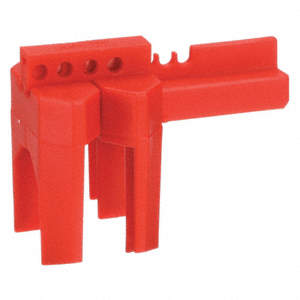Lockout Tagout Devices To Use

Proper lockout tagout (LOTO) practices and procedures safeguard workers from hazardous energy releases. OSHA's Lockout/Tagout Fact Sheet describes the practices and procedures necessary to disable machinery or equipment to prevent hazardous energy release. The OSHA standard for The Control of Hazardous Energy (Lockout/Tagout) (29 CFR 1910.147) for general industry outlines measures for controlling different types of hazardous energy. The LOTO standard establishes the employer's responsibility to protect workers from hazardous energy. Employers are also required to train each worker to ensure that they know, understand, and are able to follow the applicable provisions of the hazardous energy control procedure.
Kits and locks ranging from drum seals all the way to cabinets and stations can be used as devices to ensure the safety and procedures of lockout tagout. The list below will go through the different items that can be used to protect your workers.
-
Cable Locks
Cable lockouts are for use on devices difficult to lock through conventional means. They cinch cables in place to keep handles and/or valves in a locked off position and isolate valves or electrical handles. Cable lockouts are ideal for use in industrial or commercial applications.
-
Confined Space Covers
Locking confined space covers identify a confined space and provide a secure barrier to entry that ensures no worker entry without permission.
-
Electrical Lockouts
Electrical lockouts help protect employees against potential injury from unexpected energization or startup, or release of stored energy in commercial or industrial applications. Circuit breaker lockout devices and panel kits accommodate single- and multipole breaker configurations and standard or irregular-shaped components. Plug lockout devices enclose equipment power plugs and receptacle lockouts block out electrical receptacles. Push-button lockout devices are available for a variety of button diameters. Switch lockout devices prevent power switches from being flipped to the on position.
-
Flange Lockout Devices
Flange lockout devices fully conceal flange bolts to prevent access to the blind flange to protect workers during pipeline maintained.
-
Gas Cylinder Lockouts
Gas cylinder lockouts allow access to the valve handle without removing the protective cap and replacing the regulator each time the cylinder is needed. They prevent access to the main cylinder valve for greater safety and controlled access to the gas cylinder.
-
Group Lockout Boxes
Group lockout boxes store keys used for power sources and machines to ensure that they are not started while someone is working on them.
-
Ladder Lockout Devices
Ladder lockout devices discourage unauthorized use for fixed ladders attached to buildings or for portable ladders used on jobsites.
-
Lockout Hasps
Lockout hasps can lock out power sources (such as disconnects and switches) and require multiple authorizations for access to one locked out device or energy source to help ensure employee safety in commercial and industrial environments.
-
Lockout Padlocks
Lockout padlocks help secure locked out equipment and prevent accidental start-up of equipment during maintenance. They can be keyed alike or different depending on the commercial or industrial application.
-
Lockout Stations and kits
Lockout stations and kits help employees stay safe while following energy control lockout tagout programs. Lockout centers and stations help employees find most of the lockout supplies they need while portable stations keep needed supplies close at hand for contractors and maintenance personnel.
-
Lockout Tags
Lockout tags are highly visible and describe the status of intentionally disabled equipment to employees for worker safety in industrial and commercial applications. Most have information on why the lockout is required, time the lockout tag (and lock) was installed, and the name of the authorized person who attached the tag and lock to the system.
-
Pneumatic Locks
Pneumatic lockouts prevent access to pneumatic regulators and fittings to disable equipment and protect workers from injury.
-
Steering Wheel Lockouts
Steering wheel lockouts attach to a vehicle's steering wheel and alert that the vehicle is being serviced and should not be operated or moved to protect personnel from injury.
-
Valve Lockout Device
Valve lockout devices, such as ball valves, butterfly valves, and gate valve lockouts, block the accidental opening of valves during system repair to protect workers from injury in commercial and industrial applications.
A way to manage your locks and tags is through creating Lock Out Tag Out Procedures. A great online application to assist in the LOTO procedure process is LOTOBuilder. Try LOTOBuilder today! It is currently available for a FREE 30-day trial which will allow you to manage your lock out tag out program from start to finish. Easily enter your workers, equipment and LOTO procedures to build an entire LOTO program. Save time and money using LOTOBuilder.
To support assessing job task risks, a great companion to LOTOBuilder is the online Job Safety Analysis (JSA) software, JSABuilder, which inexpensively allows teams to prepare JSAs and Activity Hazard Analyses (AHAs). It's also FREE to try out JSABuilder, to discover this outstanding Jon Hazard Analysis (JHA) software that will help your team work safely and go home at the end of each workday without harm. Follow JSABuilder on Twitter @JSABuilder, where we tweet about Health and Safety, post LOTO Safety tips, and provide updates on current Health and Safety topics.
Images, links, brands discussed or displayed in this article are not endorsements or recommendations. They are for illustration of various products and types of products. JSABuilder does not recommend products, does not endorse products, or express any opinion as to the applicability to any given use case or job hazard.
Sources:
https://www.osha.gov/control-hazardous-energy
https://www.grainger.com/category/safety/lockout-tagout














